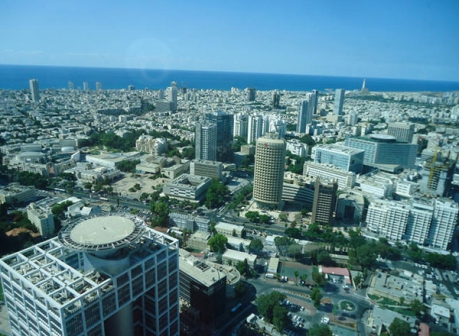
The visual effect of the white buildings in Tel Aviv creates a sense of cleanliness and striking metropolis.
The architectural design in the leading innovation city is simple and attractive. Many buildings constructed in Bauhaus’ international style has earned Tel Aviv, a recognition. In the year 2003, UNESCO added Tel Aviv to its World Heritage Sites for its unique historic buildings.
The buildings can be spotted all over the city which has preserved the international architecture in the world. In the White City, schools, parks, offices and living houses were considered to be the World Heritage Site.
Besides its 14kilometres of beaches, 318 days of sunshine per year, which ranked the city as the third best city to visit in the world according to Lonely Planet, the exceptional architectural buildings also played a role.
The buildings were constructed between 1920 and 1950s by German Jews who migrated to the region. They set up several buildings in the city in the international (Bauhaus) style.
As a result of immigration waves from Germany to Israel after the increasingly Nazi ideology, the immigrants reformed Tel Aviv into a recognized ‘White City.’
Tel Aviv, which was founded in 1909 during British rule developed into a blooming city.
According to UNESCO, the White City of Tel Aviv is a synthesis of outstanding significance of the various trends of the Modern Movement in architecture and town planning in the early part of the 20th century.
“Such influences were adapted to the cultural and climatic conditions of the place, as well as being integrated with local traditions. The architecture is a synthetic representation of some of the most significant trends of Modern Movement in architecture, as it developed in Europe,” it says.
The architects who studied in the Bauhaus School of Architecture and fine arts immigrated with the skills they had learnt, shaping and transforming Tel Aviv into a city it is today.
architectural school
The school, which was started by a group of young people with the aim of changing architectural approach and design, was founded in 1919 in Weimar, Germany. The school was, however, closed by Nazi government in 1933.
“As much of Germany was destroyed during the war, Tel Aviv has the highest concentration of Bauhaus buildings in the world, with 4,000 buildings. The nickname given to the area with the Bauhaus building is The ‘White City’, as all of the Bauhaus buildings are white,” says International Press Director for Tel Aviv Global, Mira Marcus. From 1930’s to the 1950’s, the Bauhaus buildings which were built by architects such as Ze’ev Rechter, Joseph Neufeld, Arieh Sharon, Dov Carmi, Carl Rubin, Shmuel Barkai and Benjamin Chlenov were over 4,000.
Tel Aviv’s first and prominent city engineer Yehuda Magidovitch planned over 500 buildings.
Stay informed. Subscribe to our newsletter
The style if slightly different from the international style since the architects had to consider the climate of Israel’s.
The Bauhaus architectural style is simple with white walls with no unnecessary decoration. It is also characterised by small round balconies which make the buildings appealing.
Additionally, Bauhaus buildings have flat roofs, white washed plaster and horizontal instead of vertical window. It also has minimal ornamentation with the first floor raised on pillars.
The city of Tel Aviv has 420,000 residents with greater Tel Aviv area having is 3.4 million residents. The innovation sector in the start-up city is growing by 20 per cent each year.
Remarkably, the city initiated a major preservation plan for the historic buildings, an activity which has been on going to date.
 The Standard Group Plc is a
multi-media organization with investments in media platforms spanning newspaper
print operations, television, radio broadcasting, digital and online services. The
Standard Group is recognized as a leading multi-media house in Kenya with a key
influence in matters of national and international interest.
The Standard Group Plc is a
multi-media organization with investments in media platforms spanning newspaper
print operations, television, radio broadcasting, digital and online services. The
Standard Group is recognized as a leading multi-media house in Kenya with a key
influence in matters of national and international interest.
 The Standard Group Plc is a
multi-media organization with investments in media platforms spanning newspaper
print operations, television, radio broadcasting, digital and online services. The
Standard Group is recognized as a leading multi-media house in Kenya with a key
influence in matters of national and international interest.
The Standard Group Plc is a
multi-media organization with investments in media platforms spanning newspaper
print operations, television, radio broadcasting, digital and online services. The
Standard Group is recognized as a leading multi-media house in Kenya with a key
influence in matters of national and international interest.









